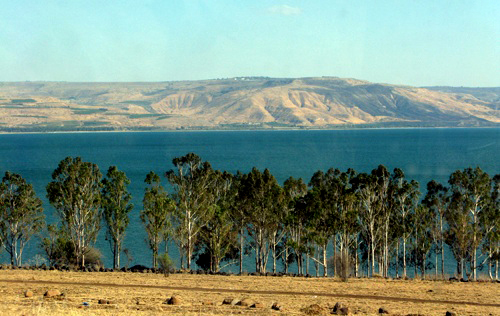
The region around the Sea of Galilee and the Jewish province furthest from Jerusalem in ancient times; it was also where Jesus spent most of his lifetime.
Geographically, it was (and remains) among the most luxurious and scenic regions of Israel, a garden of green amidst the drab of the brown that most of us have come to associate with Israel.
Open Map ☰

The Sea of Galille, looking east towards
the Golan Heights (ancient Bashan).
In ancient times, Galilee was the home of the tribe of Naphtali (Jos 20:7) and Zebulun (Matt 4:13). Solomon, in return for the supply of cedar, pine and gold for the building of the Temple, gave Hiram the king of Tyre twenty towns in Galilee. Possibly because of this, and also because its original inhabitants before the arrival of the Israelites were never completely displaced, Isaiah calls it "Galilee of the Gentiles" (Isa 9:1).

View from a kibbutz on the southern
shores of the Sea and looking on Tiberias.
In the times of the NT the borders of Galilee had been extended southwards so that the province of Galilee extended from Mount Hermon in the north to the ridges of Carmel and Gilboa in the south and stretching from the Jordan in the east to Acco on the Mediterranean coast. Herod managed to make Galilee the most prosperous of all his provinces. It was here where Jesus spent most of his time, growing up first in Nazareth before moving to Capernaum which became the location of most of his teaching and miracles; no less than nineteen of the thirty-two parables and twenty-five of the thirty-three miracles of Jesus were taught and wrought in this province.
Far from the cultural centers of the nation, Galilean were considered uncouthed country "bumpkins, fodder for ethnic jokes." Their speech carried a thick accent that made them easily recognizable, as Peter was while waiting in the courtyard of the High-Priest's house soon after Jesus was arrested (Mk 14:66-71; Lk 22:59). And nothing good, it seemed, could come from Galilee: when told by Philip that they had found the Messiah in Jesus of Nazareth, Nathanael responded with surprise, "Nazareth! Can anything good come from there?" (Jn 1:46). Similarly, when Nicodemus tried to get the Jewish authority to give Jesus a fair hearing, he was shouted down, "Are you also from Galilee? Look into it and you will find that no prophet has arisen out of Galilee" (Jn 7:52).
If uncultured, Galilean were also known for their political activism and violent insurrectionists. It was here that the Jewish historian Josephus began his journey into fame during the First Jewish Revolt, when he surrendered himself and made himself useful to the Romans. Though the most famous, he was not the first. When the Jewish leaders were jolted by the early apostles' refusal to bow to pressures to stop their preaching, Gamaliel calmed them by reminding them of the failures of Theudas and "[a]fter him, Judas the Galilean appeared in the days of the census and led a band of people in revolt. He too was killed, and all his followers were scattered" (Acts 5:37).
After the Second Jewish Revolt Galilee, and especially the city of Tiberias, grew to become an important centre of rabbinical learning.

Further Reading & Resources:
David Smith, "Jesus and the city: reflections on the urban context of Galilee," Evangelical Quarterly 82.4 (October 2010): 316-325.
Pdf N 6 (Open on Phone)

©ALBERITH
1001201lch